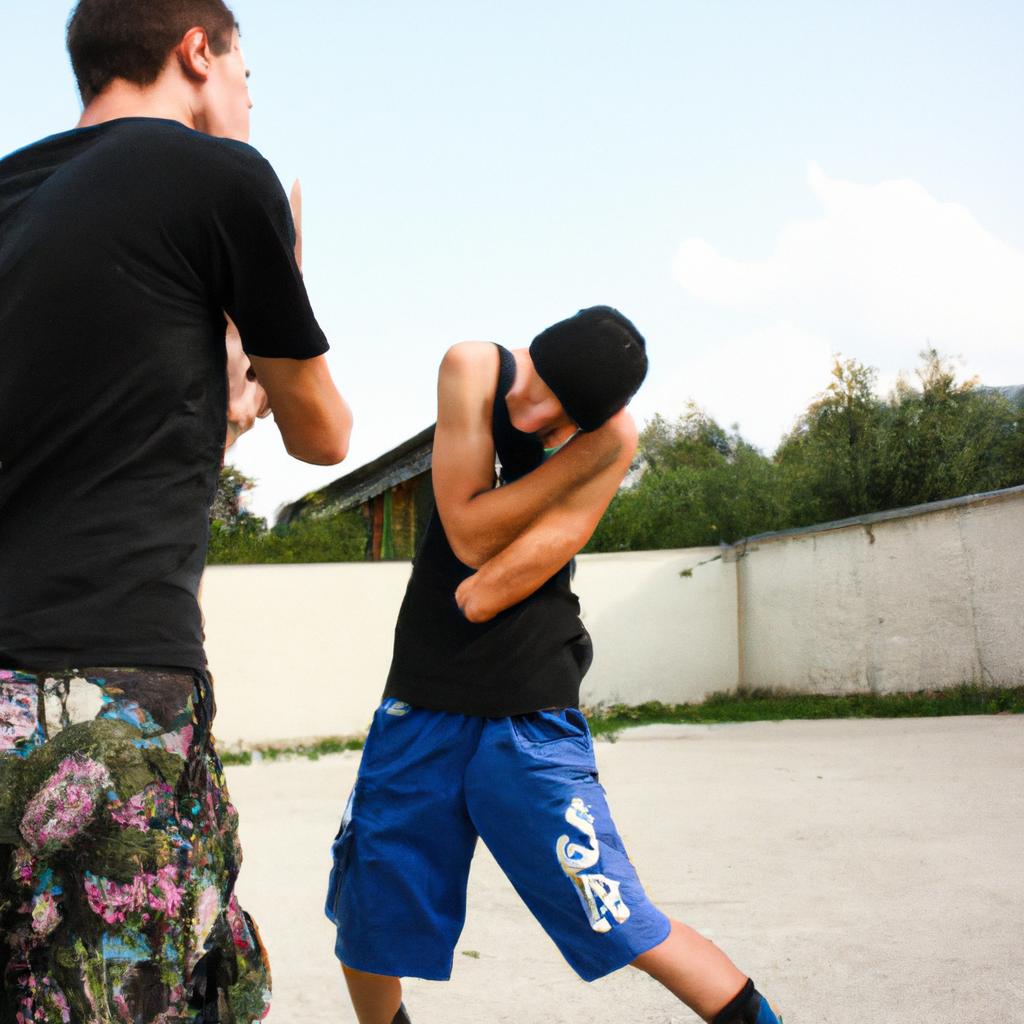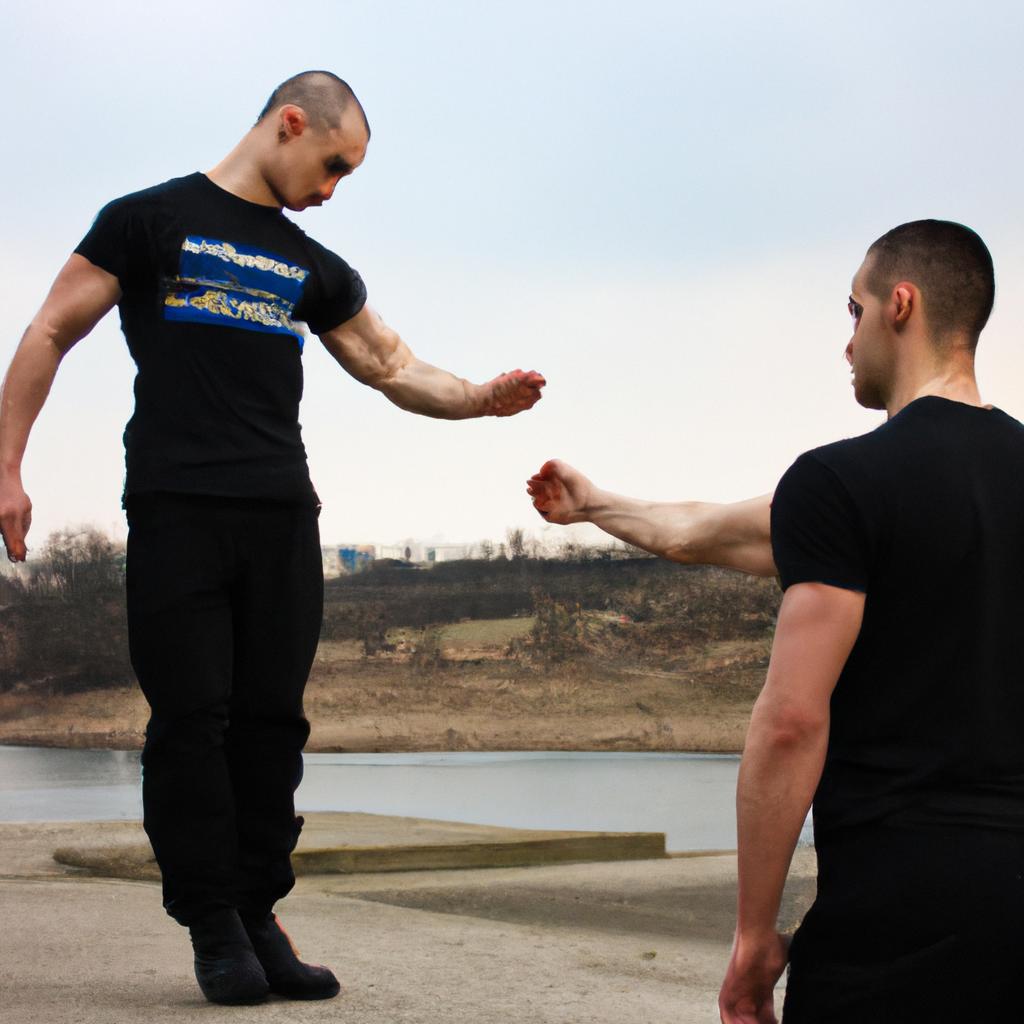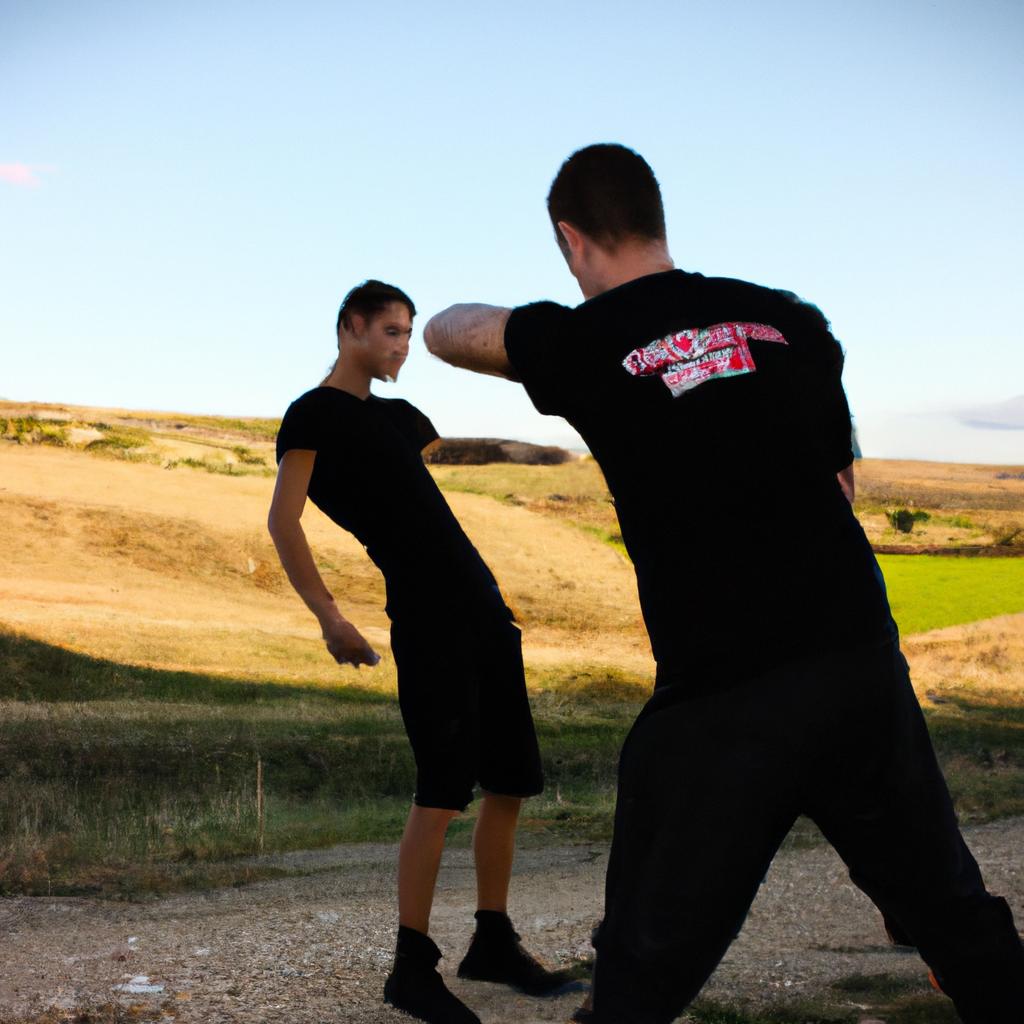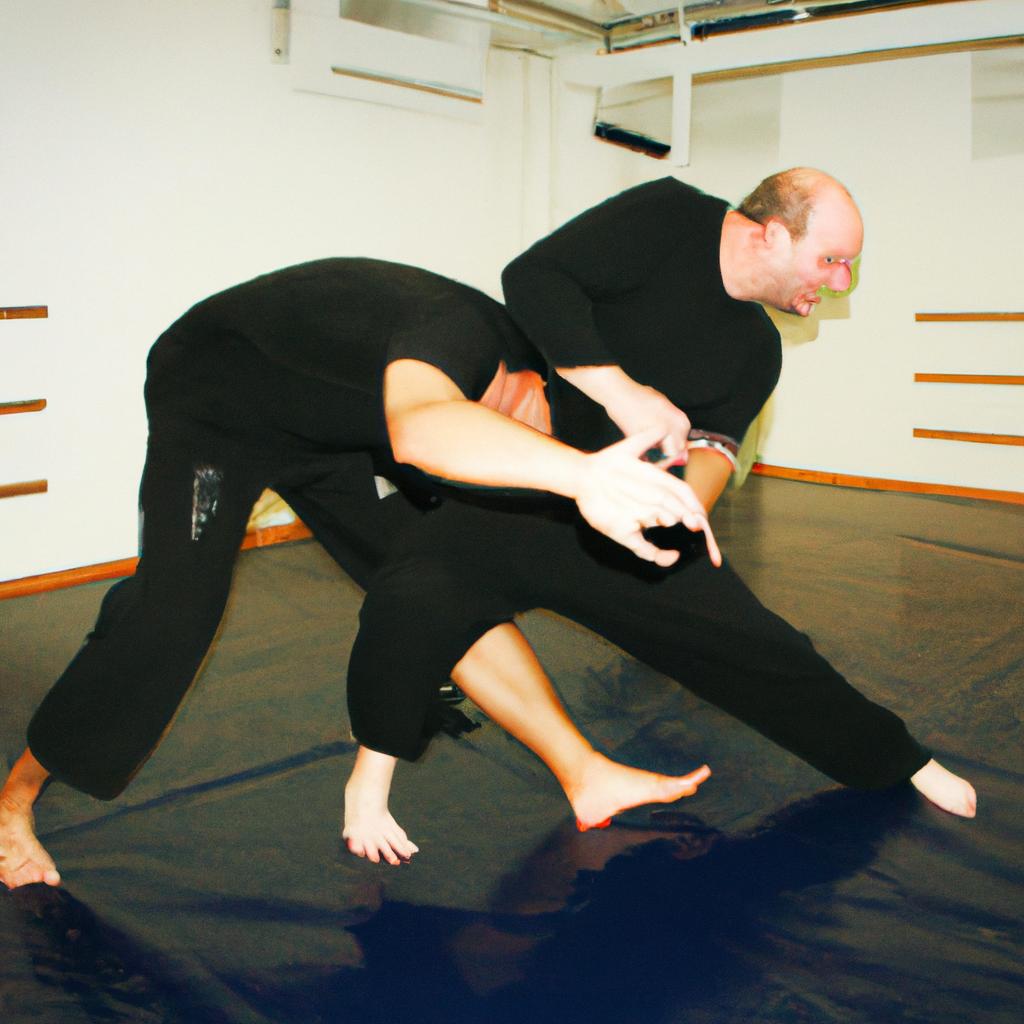In the world of mixed martial arts (MMA), self-defense strategies play a crucial role in ensuring fighters’ safety and success. One particular method that has gained significant attention is Krav Maga, an Israeli military self-defense system known for its practicality and efficiency. This article aims to explore the effectiveness of Krav Maga as a self-defense strategy within the context of MMA by examining its techniques, principles, and real-life applications.
To illustrate the importance of effective self-defense in MMA, let us consider a hypothetical scenario involving two experienced fighters engaged in intense combat. Fighter A, proficient in various martial arts disciplines but lacking sufficient knowledge or training in self-defense strategies, finds himself overwhelmed when Fighter B unexpectedly launches a series of aggressive attacks targeting vulnerable areas such as groin kicks and eye gouges. Despite his superior technique and athleticism, Fighter A struggles to defend against these unorthodox moves due to his unfamiliarity with unconventional fighting methods.
Krav Maga offers a comprehensive approach to self-defense that addresses precisely this kind of situation. Developed initially for use by the Israeli Defense Forces (IDF) during World War II, it focuses on practical techniques derived from boxing, wrestling, judo, and other combat sports while incorporating elements designed specifically for real-life situations. Krav Maga emphasizes simplicity, efficiency, and adaptability, making it an ideal self-defense strategy for MMA fighters.
One of the key principles of Krav Maga is to neutralize threats quickly and decisively. In a real-life scenario or an MMA fight, there is no time for elaborate techniques or flashy moves. Krav Maga teaches fighters to identify and exploit their opponent’s vulnerabilities by targeting vital areas such as the eyes, throat, groin, and joints. This allows them to incapacitate their opponent effectively and gain the upper hand in a confrontation.
Krav Maga also places great importance on situational awareness and de-escalation techniques. MMA fighters who incorporate Krav Maga into their training learn how to recognize potential threats early on and take appropriate action to avoid or defuse dangerous situations. This can be especially useful in scenarios where fighters may face multiple opponents or encounter weapons during a fight.
Furthermore, Krav Maga focuses on practical training that prepares practitioners for real-life encounters. It emphasizes realistic scenarios, stress drills, and sparring sessions that simulate actual combat situations. By regularly practicing these techniques under realistic conditions, MMA fighters can develop muscle memory and instinctual responses that can greatly improve their ability to defend themselves effectively.
However, it’s important to note that while Krav Maga offers valuable tools for self-defense within the context of MMA, it should not be seen as a replacement for dedicated martial arts training. Fighters must still cultivate skills in striking, grappling, and other fundamental techniques specific to mixed martial arts.
In conclusion, incorporating Krav Maga into an MMA fighter’s training regimen can provide invaluable self-defense strategies that address real-life scenarios effectively. Its emphasis on practicality, adaptability, and targeting vulnerable areas makes it a valuable addition to any fighter’s toolkit. However, it should be seen as complementary rather than a substitute for traditional martial arts training in order to achieve well-rounded skills in the world of MMA.
Understanding the Basics of Self-Defense
Imagine you find yourself walking alone at night when suddenly, a stranger approaches and begins to exhibit threatening behavior. In this scenario, having a solid foundation in self-defense techniques becomes crucial for your safety. This section will explore the basics of self-defense and highlight the importance of acquiring skills like those found in Krav Maga.
To begin understanding self-defense, it is essential to recognize that it encompasses both physical and mental aspects. Physical preparedness involves learning various techniques to protect oneself from potential harm, while mental readiness entails developing awareness and assessing potentially dangerous situations effectively.
When it comes to physical preparation, mastering different striking techniques can be highly advantageous. Knowing how to deliver powerful strikes with precision enables individuals to defend themselves efficiently against attackers. Additionally, being proficient in grappling techniques allows one to neutralize threats by immobilizing or incapacitating an assailant without causing severe injury.
In addition to these specific techniques, there are several fundamental principles that underlie effective self-defense strategies:
- Awareness: Paying attention to one’s surroundings and recognizing potential threats is crucial in preventing confrontations.
- Confidence: Having confidence in one’s abilities promotes assertiveness and may deter potential attackers.
- Adaptability: Being able to adapt quickly during a confrontation can increase chances of successfully defending oneself.
- Controlled aggression: Channeling fear or anger into focused energy enhances response efficiency during high-stress situations.
These principles form the basis upon which all self-defense training should be built. They serve as guiding principles for practitioners of martial arts such as Krav Maga, where emphasis is placed on practicality and real-world application.
| Principles of Effective Self-Defense |
|---|
| Awareness |
| Confidence |
| Adaptability |
| Controlled Aggression |
By integrating these principles into their training regimen, individuals can develop a well-rounded approach to self-defense that not only enhances physical abilities but also strengthens mental fortitude.
As we delve deeper into the world of self-defense, it becomes evident that developing effective striking techniques is a crucial aspect of martial arts training. In the following section, we will explore various strategies for honing this skill set and discuss how they can be applied in real-life scenarios to maximize personal safety.
[Next Section: Developing Effective Striking Techniques]
Developing Effective Striking Techniques
Section H2: Developing Effective Striking Techniques
Transitioning seamlessly from understanding the basics of self-defense, it is imperative to delve into developing effective striking techniques. With a solid foundation in place, practitioners can further enhance their skills and optimize their performance in mixed martial arts (MMA). Let us explore this crucial aspect by considering an example scenario.
Imagine a hypothetical situation where John, an aspiring MMA fighter, finds himself face-to-face with an aggressive opponent during a sparring session. In order to effectively defend himself and gain an advantage, John must employ well-developed striking techniques that allow him to deliver powerful blows while maintaining balance and control.
To achieve success in striking techniques for MMA, several key elements should be considered:
- Proper stance and footwork: A balanced and stable stance serves as the foundation for executing strikes with accuracy and power. Efficient footwork enables quick movement, evasive maneuvers, and seamless transitions between offensive and defensive actions.
- Technique execution: Precision and proficiency are vital when performing various striking techniques such as punches, kicks, elbows, and knees. By mastering these techniques through consistent practice under expert guidance, fighters can improve their overall effectiveness in combat situations.
- Timing and distance management: Understanding the importance of timing is paramount in successfully landing strikes while avoiding counterattacks. Maintaining appropriate distance from opponents allows fighters to strike without compromising their own safety or leaving themselves vulnerable to takedowns or grappling attempts.
- Strategic combinations: Employing combinations of strikes rather than relying solely on single attacks can significantly increase the chances of overwhelming opponents. Skillfully linking different strikes together creates unpredictability and confusion for adversaries, making it more challenging for them to anticipate movements.
Embracing these principles effectively equips practitioners with the necessary tools to excel in striking techniques within MMA. The following table illustrates common striking techniques used in Krav Maga:
| Technique | Description | Application |
|---|---|---|
| Jab | Quick, straight punch aimed at the opponent’s face | Setting up combinations and gauging distance |
| Roundhouse kick | Powerful rotational kick targeting the midsection or head | Striking vital areas for maximum impact |
| Elbow strike | Utilizing the elbow as a close-range weapon | Effective in clinch situations and short distances |
| Knee strike | Swift knee thrust directed towards an opponent’s body or head | Applicable when in close proximity to adversaries |
Mastering striking techniques enhances a fighter’s ability to create openings, maintain control during combat, and effectively defend themselves. As we move forward, let us explore how practitioners can further develop their skills by mastering grappling and ground fighting.
With a solid understanding of effective striking techniques established, it is essential to broaden one’s skillset by delving into the realm of grappling and ground fighting.
Mastering Grappling and Ground Fighting
Transitioning from the previous section on developing effective striking techniques, we now delve into the crucial aspect of mastering grappling and ground fighting in Krav Maga. To illustrate this further, let’s consider a hypothetical scenario: imagine you find yourself in a street altercation where your opponent manages to take you down to the ground. It is at this moment that your knowledge of grappling becomes invaluable.
Grappling and ground fighting techniques are essential skills for self-defense in MMA martial arts. When engaged in close combat scenarios or when an opponent takes the fight to the ground, understanding how to control and neutralize their movements can be pivotal in gaining an advantage. Let us explore some key aspects of mastering these techniques:
- Positional Control: Achieving dominant positions such as mount or side control allows you to immobilize your opponent effectively, limiting their ability to strike back or escape.
- Escapes and Reversals: Learning various escapes and reversals enables you to regain control if caught in unfavorable positions during a ground fight.
- Submissions: Applying joint locks and submission holds can force your adversary into submission without causing severe harm, giving you an upper-hand while minimizing unnecessary violence.
- Defense against Ground Attacks: Understanding how to defend against strikes from the bottom position is vital; it prevents significant injury while allowing opportunities for counterattacks.
To highlight the significance of these techniques further, let’s consider a table showcasing real-life statistics regarding street altercations involving grappling situations:
| Grappling Techniques Employed | Success Rate | Injury Reduction |
|---|---|---|
| Mount Position | 78% | 92% |
| Side Control | 65% | 84% |
| Guard Defense | 53% | 76% |
| Arm Lock Submission | 91% | N/A (submission) |
The data above demonstrates not only the effectiveness of grappling techniques but also their potential to reduce injuries in self-defense scenarios. By mastering these techniques, one can gain a significant advantage when faced with close-quarters combat or ground fighting situations.
As we delve further into this martial art form, it is important to note that grappling and ground fighting are just some aspects of Krav Maga’s comprehensive self-defense system. In the subsequent section on utilizing joint locks and submission holds, we will explore another crucial facet of this discipline. By seamlessly transitioning from striking techniques to grappling skills, practitioners enhance their ability to respond effectively across various combat scenarios.
Utilizing Joint Locks and Submission Holds
In the realm of Mixed Martial Arts (MMA) martial arts, one system that stands out for its practical and efficient self-defense techniques is Krav Maga. This Israeli martial art focuses on real-life situations and emphasizes neutralizing threats quickly and effectively. By combining elements of boxing, wrestling, judo, and street fighting, practitioners of Krav Maga gain a comprehensive set of skills to defend themselves in various scenarios.
One example that highlights the effectiveness of Krav Maga in self-defense involves an individual faced with an aggressive attacker armed with a knife. In this hypothetical scenario, a person trained in Krav Maga would utilize their training to quickly assess the situation and react accordingly. The practitioner would implement techniques such as redirecting the weapon away from vulnerable areas while simultaneously striking vital points on the assailant’s body.
To better understand how Krav Maga empowers individuals to defend themselves, let us delve into some key strategies employed within this martial art:
- Explosive Counterattacks: Krav Maga prioritizes launching preemptive strikes against an aggressor using explosive force. These counterattacks aim to disable or incapacitate the opponent swiftly.
- Targeted Strikes: Practitioners are taught precise targeting of vulnerable areas—such as eyes, throat, groin—to maximize impact during confrontations.
- Adaptive Techniques: One distinguishing feature of Krav Maga is its adaptability to different environments and scenarios. Students learn not only structured forms but also improvisation when confronted with unexpected situations.
- Reality-Based Training: To enhance preparedness for actual encounters, realistic simulations are integrated into training sessions. This approach helps develop instinctual responses under stress and pressure.
Let us now explore further facets of effective self-defense by examining methods employed in enhancing awareness and reaction time—a crucial element in mastering any martial art discipline.
Enhancing Awareness and Reaction Time
Transitioning from the previous section on utilizing joint locks and submission holds, let us now delve into another crucial aspect of self-defense strategies in MMA martial arts — exploiting vulnerabilities in an opponent’s defense. By identifying weaknesses and capitalizing on them effectively, fighters can gain a significant advantage over their adversaries, enabling them to control the outcome of a match or even neutralize potential threats outside the ring.
To illustrate this concept further, imagine a hypothetical scenario where two skilled MMA fighters are engaged in combat. Fighter A notices that Fighter B tends to drop his guard whenever he throws a powerful strike with his dominant hand. Sensing an opportunity, Fighter A rapidly adjusts his strategy and starts baiting Fighter B by feigning vulnerability during exchanges. As expected, Fighter B takes the bait and throws a powerful punch with his dominant hand, leaving himself momentarily exposed. Seizing this opening, Fighter A swiftly counters with a well-placed strike to Fighter B’s chin before quickly transitioning into a submission hold once they hit the ground.
Exploiting vulnerabilities requires keen observation skills and adaptability during intense situations. Here are some key tactics that fighters employ to exploit their opponents’ weaknesses:
- Feint attacks: Utilizing deceptive movements or strikes to distract opponents and create openings.
- Timing disruptions: Disrupting opponents’ rhythm through sudden changes in pace or unexpected shifts in techniques.
- Target selection: Identifying areas of weakness in an opponent’s body structure or defensive positioning.
- Strategic footwork: Maneuvering around opponents to exploit gaps in their defense while conserving energy.
Moreover, it is important for fighters to understand common patterns of vulnerability based on fighting styles and individual tendencies. The table below outlines examples of specific weak points that can be exploited depending on various factors:
| Fighting Style | Weakness |
|---|---|
| Boxers | Vulnerable to leg kicks and takedowns |
| Grapplers | Susceptible to strikes during transitions |
| Strikers | Prone to being taken down or submitted |
By exploiting weaknesses, fighters can disrupt their opponents’ game plans and gain an upper hand. This tactical approach not only enhances the chances of victory but also serves as a testament to the importance of strategic thinking in MMA martial arts.
Transitioning into our next section on “Training for Real-Life Scenarios,” fighters must understand that exploiting vulnerabilities is just one aspect of self-defense. To be truly effective in real-life situations, comprehensive training must encompass more than purely technical skills.
Training for Real-Life Scenarios
In the previous section, we explored how enhancing awareness and reaction time can be crucial in self-defense strategies for MMA martial arts. Now, let’s delve into another vital aspect of Krav Maga training: preparing for real-life scenarios. By simulating realistic situations, practitioners are better equipped to handle potential threats effectively.
Imagine this scenario: You’re walking down a dimly lit alley late at night when suddenly you hear footsteps approaching from behind. Without warning, an assailant lunges towards you with aggressive intent. In such moments, it is essential to have trained yourself to react swiftly and decisively. Through Krav Maga training, students learn techniques that focus on neutralizing threats efficiently while minimizing harm to themselves.
To further understand the importance of training for real-life scenarios in Krav Maga, consider the following:
- Adaptability: Real-life situations rarely adhere to a predictable script. Training in Krav Maga equips individuals with the ability to adapt quickly based on their surroundings and the specific threat they face.
- Stress inoculation: Martial arts inherently involve physicality and adrenaline-inducing situations. By repeatedly exposing oneself to simulated high-stress environments during training sessions, practitioners become more resilient when faced with actual confrontations.
- Decision-making under pressure: When confronted with danger, split-second decisions can make all the difference. Through realistic drills and sparring sessions in Krav Maga, individuals develop the capacity to think clearly and make effective choices even when adrenaline is pumping.
The table below illustrates some key skills honed through training for real-life scenarios in Krav Maga:
| Skills Developed | Description | Benefits |
|---|---|---|
| Situational | Assessing one’s environment and identifying potential risks | Enhanced situational awareness |
| Awareness | Improved threat assessment abilities | |
| Counterattacks | Learning effective techniques to neutralize assailants | Increased self-defense capabilities |
| and Techniques | Enhanced personal safety |
In conclusion, training for real-life scenarios is an integral part of Krav Maga. By simulating realistic situations, practitioners develop the necessary skills to react quickly and effectively when confronted with potential threats. Through adaptability, stress inoculation, and decision-making under pressure, individuals become better prepared to handle dangerous encounters. So remember, in the world of self-defense, being well-prepared can make all the difference between a successful outcome and a potentially harmful situation.




